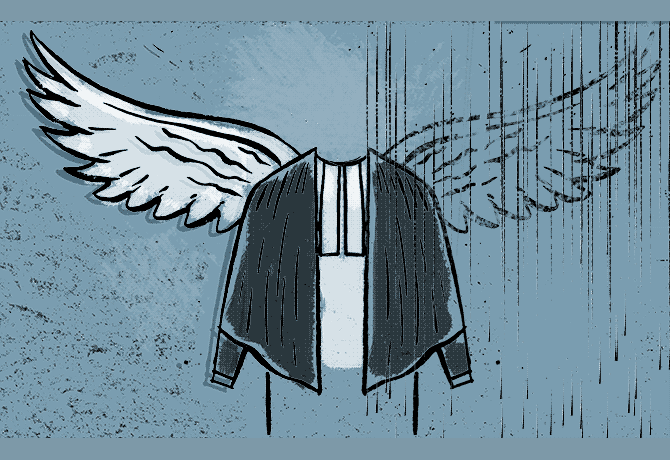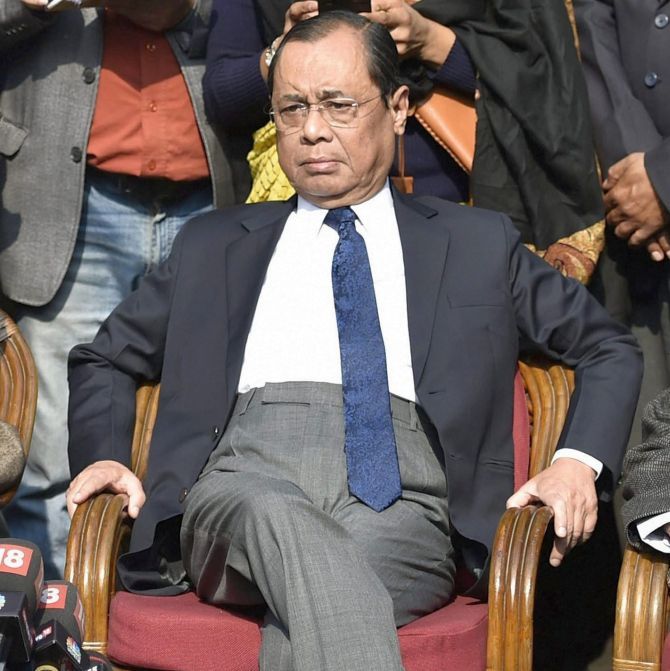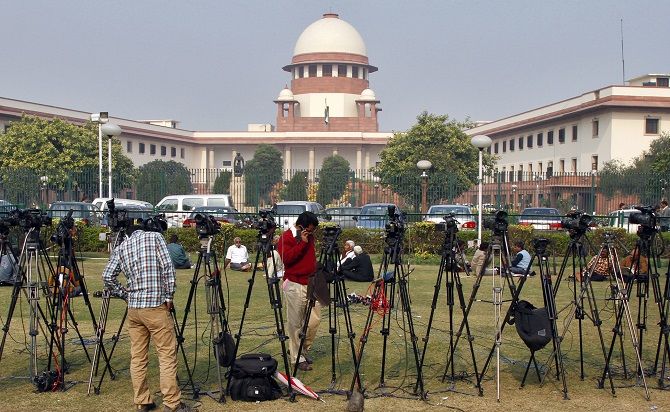 | « Back to article | Print this article |
'There is one weapon in the government's armoury which impacts the independence of the judiciary, and which has not been affected by the collegium system.'
'It is post-retirement employment with the government.
'This is because some judges -- but not all -- are offered post-retirement employment by the government, and it has often been feared that judges close to retirement might decide cases so as to please the government in order to get a favourable post-retirement position,' says Abhinav Chandrachud.
Illustration: Dominic Xavier/Rediff.com

In 1977, Justice P B Gajendragadkar wrote a note to Prime Minister Morarji Desai which recommended that a new system (which resembled what we would now refer to as the collegium system) be put into place for appointing judges.
The collegium system came into force in the 1990s, as a result of a judgment of the Supreme Court, according to which judges are appointed on the basis of binding recommendations made by the Chief Justice of India and a certain number of his senior colleagues.
The collegium system had no real precedent in India and made three broad changes to the system of appointing judges.
Firstly, it gave an institutionalised role to the senior colleagues of the Chief Justice of India, who had hitherto only been informally consulted, on occasion, over judicial appointments.
Prior to the collegium system, it was not obligatory for the Chief Justice of India to consult his senior colleagues while recommending names for judicial appointments.
This changed under the collegium system, after which the Chief Justice of India can no longer ignore the views of his senior colleagues while making appointments.
In other words, the 'primacy' of the Chief Justice of India over his colleagues ended with the collegium system.
Prior to the collegium model of appointing judges, some Chief Justices of India would consult their senior colleagues (or colleagues who came from the same region as the judge who was being considered for elevation) before making judicial appointments, but this was an informal, not an institutionalised, practice.
Its prevalence varied from one chief justice to the other.
However, the one Chief Justice of India who definitely broke from this tradition was Mohammed Hidayatullah.
When Hidayatullah recommended the names of A N Ray, P Jaganmohan Reddy and I D Dua (these judges were appointed to the Supreme Court in August 1969), he did not consult his senior colleagues.
Though Hidayatullah said he had consulted most of his colleagues on these names (he even claimed to have been the first Supreme Court Chief Justice to have consulted his junior colleagues at the court on Supreme Court appointments), his successor J C Shah said that he had not been consulted on these appointments or others made by Hidayatullah.
The practice of the Chief Justice of India consulting senior judges on Supreme Court appointments started disintegrating thereafter.
Chief Justice A N Ray consulted his colleagues only infrequently.
Justice Y V Chandrachud said while he started off his tenure as chief justice by consulting his colleagues (he would initially consult four or five colleagues), he stopped discussing judicial appointments with his colleagues once P N Bhagwati betrayed him on the M N Chandurkar nomination.
His rival, Justice Bhagwati, was quite miffed about this and said that Chandrachud had shown him a list of a few names at the last minute before they were appointed in March 1983 and that he did not really seek Bhagwati's concurrence.
Chief Justice R S Pathak said he consulted his colleagues, but did not seek their concurrence. '(The) list,' he said, 'is ultimately mine,' adding, 'It is the responsibility of the (chief justice of India) to be the final determiner of the list.'
In short, the collegium system essentially institutionalised the informal practice, which appeared to have been in vogue until Chief Justice Hidayatullah's time, of the Chief Justice of India consulting his most senior colleagues prior to making judicial appointments.
However, never before, prior to the collegium system, were the opinions of senior colleagues binding on the Chief Justice of India.
In other words, the collegium system did away with the 'preponderating voice', the 'primacy' of the Chief Justice of India in judicial appointments.

Secondly, the collegium system made the recommendations of the Chief Justice of India and his senior colleagues binding on the executive government.
No longer could a post-collegium minister prevail upon the Chief Justice, as Vallabhbhai Patel had over Justice M H Kania in the matter of appointing Basheer Ahmed Sayeed to the Madras high court or as P Shiv Shankar had in forcing Chandrachud to appoint Baharul Islam to the Supreme Court.
Earlier, a fiction was maintained that all appointments were made with the notional 'concurrence' of the Chief Justice of India, even when the Chief Justice had been essentially forced into a compromise.
However, the collegium system converted that fiction into reality.
Thirdly, under the collegium system, the other methods which were used by the government to intimidate judges after 1971 are no longer in vogue.
There were many tools which the government used in order to tamper with the independence of high court judges: Supersessions, transfers and the non-confirmation of additional judges and acting chief justices.
The government used supersessions to curb the independence of Supreme Court judges. These tools ceased to be of any consequence after the collegium system came into place.
However, there is one more weapon in the government's armoury which impacts the independence of the judiciary, and which has not been affected by the collegium system.
It is post-retirement employment with the government.
After retirement, some judges in India are offered positions by the government and the collegium does not control the allocation of these positions.
Unlike federal judges in the US, judges in India do not have life tenure -- they do not hold their offices for life.
They continue in office until they reach the retirement age, which is 65 at the Supreme Court and 62 at the high courts.
These judges do not hold their offices during the 'pleasure' of the President, but due to good behaviour.
In other words, they cannot be arbitrarily removed by the government once they are appointed and can only be impeached by a supermajority of both Houses of Parliament -- on the ground of proved misbehaviour or incapacity.
The impeachment process is very difficult and never in the history of independent India has a judge been successfully impeached to date, though attempts have sometimes been made to do so.
Judges therefore enjoy security of tenure while holding office, which is essential for the maintenance of judicial independence.
However, the retirement of judges threatens to undermine judicial independence.
This is because some judges, but not all, are offered post-retirement employment by the government, and it has often been feared that judges close to retirement might decide cases so as to please the government in order to get a favourable post-retirement position.
The Constitution provides that a retired Supreme Court judge cannot 'plead or act in any court or before any authority within the territory of India'.
Initially, the Constitution imposed the same restriction on retired high court judges as well.
However, after 1956, a retired high court judge was allowed to practise in the Supreme Court and in any high court in which that judge did not serve as a permanent judge.
The rule for retired high court judges was relaxed because it was considered to be '(an) important factor affecting the selection of high court judges from the bar'.
Additional judges who are not made permanent (including those who resign before being made permanent) can practise in the same high court.
On retiring at the age of 65 from the Supreme Court in September 1951, Justice Fazl Ali's term was extended under the provision of the Constitution which allows the Chief Justice of India to get retired Supreme Court judges to serve at the court.
While he was serving this extended term of office, an announcement was made that Fazl Ali would be appointed as the governor of Orissa. This raised 'a question of Constitutional propriety' relating to the independence of the judiciary.
After all, though the decision of the government in Fazl Ali's case might have been well intentioned, could the government not use such tactics in the future to reward judges who had decided cases in its favour?
In its 14th report in 1958, the Law Commission noted that retired Supreme Court judges used to engage in two kinds of work after retirement: Firstly, 'chamber practice' (a term which would, today, mean giving opinions to clients and serving as arbitrators in private disputes) and, secondly, 'employment in important positions under the government'.
The Law Commission said that chamber practice was undesirable, but did not recommend that it be banned altogether.
However, it did recommend banning post-retirement government employment for Supreme Court judges.
On chamber practice, the Law Commission opined that this was inconsistent with the dignity of a retired Supreme Court judge and inconsonant with the high traditions which retired judges observe in other countries.
Perhaps this was a little unfair because pensions paid to retired Supreme Court judges in India are not consistent with their dignity or consonant with what is paid in other countries, and retired Supreme Court judges cannot be expected to live on those pensions alone (though the Law Commission also recommended that pensions be raised).

The Law Commission called for banning post-retirement employment for Supreme Court judges with the government since the government was a large litigant in the Supreme Court.
The Law Commission made similar recommendations for high court judges. It said that chamber work was undesirable, but did not recommend banning it outright.
However, it called for reintroducing the pre-1956 ban against high court judges practising in the Supreme Court or other high courts, and instituting a ban against retired high court judges getting employed by the government.
A 'leading counsel in Bombay' deposed before the commission and said there were 'big clients' appearing before judges, who were, after the 1956 amendment, being seen as 'future clients' by judges, and large fees to the tune of Rs 10,000-Rs 20,000 were being charged by retired high court judges from these clients.
The Law Commission thought that allowing retired high court judges to engage in chamber practice would lead to a perception that sitting judges would not be impartial towards rich litigants, since they might be seen as potential future clients by those judges.
It recommended reintroducing the bar against high court judges practising in the Supreme Court or other high courts, saying that this was beneath the dignity of courts (since retired judges often had to comment or rely on some of their own judgments).
The Law Commission's recommendations were never implemented, and (eminent jurist, India's first and longest serving attorney general of India and the chairman of the first Law Commission of India, M C) Setalvad was unhappy with judges who took up government positions thereafter.
He was highly critical of M C Chagla, chief justice of the Bombay high court, for resigning his position in order to become India's ambassador to the US at Prime Minister Nehru's invitation.
Thereafter, Supreme Court judge Justice (Jeevan Lal) Kapur was due to retire in December 1962, and Setalvad wrote that 'like most of the retiring judges', Kapur was 'trying to secure some suitable employment'.
Kapur was appointed chairman of the Law Commission while he was still serving as a Supreme Court judge.
'The appointment was most unfortunate,' wrote Setalvad, 'and gravely affected the dignity and independence of the Supreme Court.'
Setalvad felt that as chairman of the Law Commission, Kapur would have had to advise the government on making law and might have had meetings with government officials, which was inconsistent with his position as a Supreme Court judge, since those very laws could be under challenge in cases which came up before him.
Setalvad was also critical of Chief Justice Subba Rao who resigned his office in April 1967 to run as an Opposition candidate for the position of President of India.
While Chief Justice Hidayatullah was hearing the Privy Purses case, his last judgment as Chief Justice of India, a news story had appeared that he was being considered by the government for the World Court or for the position of Lokpal.
Some lawyers and judges suggested to him that he should not hear the Privy Purses case since this was being contemplated. However, Hidayatullah made it clear that even if he were offered these positions, he would not accept them.
Several judges told George H Gadbois that post-retirement employment with the government was undermining the independence of the judiciary.
Chandrachud said some judges were looking for post-retirement positions and writing judgments with that in mind.
Bhagwati added that most judges hanker after a good retirement job because it enables them to have a rent-free house, car and driver, and allowances and also gives them some status.
Pathak believed that judges with short tenures at the Supreme Court tended to be more pro-government in their approach since they were looking for a suitable position after retirement.
The collegium system has not been able to entirely free judges from their dependence on the executive government for post-retirement employment.
Excerpted from Supreme Whispers: Conversations With Judges Of The Supreme Court Of India, 1980-1989 by Abhinav Chandrachud, with the kind permission of the publishers, Penguin Viking.